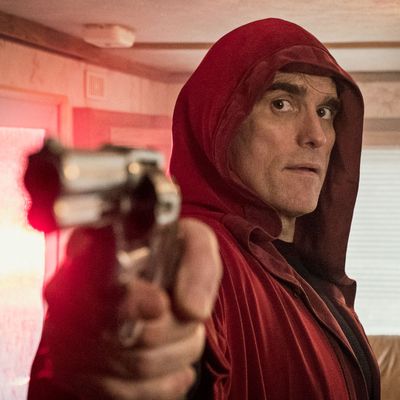
This review originally ran during the Cannes Film Festival.
It takes about an hour for Lars von Trier to make a predator/prey animal metaphor in his serial-killer movie, complete with archival nature-documentary footage and heavy-handed voice-over. According to Jack (Matt Dillon), creatively interpreting William Blake, there are tigers and lambs, and it is in the tiger’s nature to devour the lamb. Jack, of course, sees himself as a tiger — because he is a killer, but also because he likes to think of himself as an artist, burning bright and fearful. The lamb may die, but as he sees it, it has “been bestowed with the gift of living forever in art. And art is divine.” I can’t remember if his simultaneously belabored and banal musings come before or after Jack taxidermies a child he’s gunned down, but I suppose that doesn’t matter.
The House That Jack Built is a film that Cannes has been collectively bracing itself for since the news that the festival’s ban on the filmmaker, put in place after he “joked” about “understanding Hitler” at the 2011 edition, had been lifted. Word of the film’s excessive violence only exacerbated that (I heard a rumor that felt like the work of some creative PR, that paramedics and stretchers would be on hand for audience members at the premiere who couldn’t handle it, because Cannes definitely needs more of a Fear Factor vibe). As it turns out, the film’s most offensive qualities have nothing to do with its grotesque violence and displays of human mutilation, but its terminal navel-gazing and reductive, borderline harmful ideas about art. In some respects, Lars von Trier seems to only know how to make films about himself anymore; rarely has the work been so hermetic and lifeless.
Matt Dillon plays Jack, a serial killer without a twist — when a victim of his played by Uma Thurman meets him, one of the first things she tells him is that he … looks like a serial killer. And he does. He has creepy wire-rimmed glasses, drives a windowless red van, and doesn’t blink much. Over the course of the film he tells his story to an unseen listener, in five “randomly selected” incidents that take place over a 12-year period, and not necessarily in sequence. We see him bash in the skull of Thurman’s busybody with a car jack, strangle a widowed woman and drag her bloody body down the road, and shoot down a girlfriend and her two young sons on a “hunting trip,” just to name a few. Throughout this selected playlist of murders, Jack explains his theories about how and why he is driven to kill other humans, going off on tangents that range in subject from Gothic architecture to dessert wines to, of course, the Holocaust.
At one point his guide remarks how disproportionately his victims tend to be women — and women that Jack seems to think are pretty stupid, at that. One of the more unfortunate sequences involves Riley Keough as another girlfriend (how does Jack find these women? We’ll never know) whom Jack has taken to calling “Simple.” Because she’s so dumb, you see. It’s a hateful, ugly sequence that culminates in Jack drawing dotted outlines around each of Simple’s “perfect tits,” for their eventual dismemberment, and letting her even go so far as to scream and go to the police, knowing that nobody in this von Trier–written world will do anything to help her.
There is nothing to be learned in any of this, because von Trier doesn’t really care to think about if or how a viewer might be changed by a film of his, only how he is changed by making it. This is unfortunate, because I’ve been changed by a few von Trier films in my day (last and most significantly 2011’s Melancholia, at whose Cannes press conference he made his now-infamous “I’m a Nazi” comment). During another diatribe about art’s relationship to our darkest desires, von Trier flashes through scenes from his entire filmography, and I remembered fondly going into those films with my aperture open, even if they didn’t work for me, or did but didn’t age well. With Jack, von Trier is doing so much to repel and keep us at arm’s length that it’s hard to engage with the film with any kind of seriousness, from its sadistic violence to its Divine Comedy finale. You can only tell yourself those mangled children’s corpses are fake so many times before the rest of the film feels fake as well.
Von Trier, for all his redeemable and irredeemable faults, is a singular and talented artist, and there are flashes of technical and rhythmic virtuosity in Jack that I couldn’t help but admire through my grimace. An early scene where Jack, going through a period of OCD, keeps returning to the scene of a crime, imagining blood under every surface he forgot to clean, makes you feel the anxiety of the disorder, the itchy restlessness. Von Trier can be a filmmaker of great empathy when he wants to be, but it’s exhausting to see him unable to think about the artistic process as anything other than a predator/prey dynamic, something which necessarily must hurt others in the process. It hasn’t helped him in the past, and it’s certainly not helping him now.

